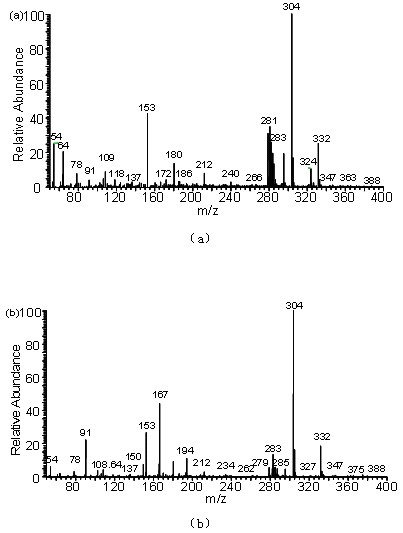Direct chemical ionization mass spectrometry detection method for illegal cooking oil
A technology of mass spectrometry detection and chemical ionization, applied in the field of detection, can solve the problems of inconvenient, time-consuming, and cumbersome operation steps in the detection of waste oil, and achieve the effect of improving the cumbersome detection operation steps
- Summary
- Abstract
- Description
- Claims
- Application Information
AI Technical Summary
Problems solved by technology
Method used
Image
Examples
Embodiment Construction
[0020] The present invention will be described in further detail below in conjunction with the accompanying drawings, but the present invention is not limited to the following embodiments.
[0021] The mass spectrometer used in the embodiments of the present invention is the LTQ-XL linear ion trap mass spectrometer of Finnigan Company of the United States, and the data processing system is the Xcalibur data processing system of Finnigan Company of the United States.
[0022] Under the optimized experimental parameters, the fingerprints of waste oil and camellia oil were recorded in negative ion mode, such as figure 1 shown. From figure 1 It can be seen that the signals with significant intensity are mainly concentrated in the mass range m / z 50-200, and after amplifying the signal intensity by a certain factor, fewer ion peaks can be seen above m / z 200. Because oil samples have higher viscosity, molecules with higher mass are not easily desorbed, and analytes with significa...
PUM
 Login to View More
Login to View More Abstract
Description
Claims
Application Information
 Login to View More
Login to View More - R&D
- Intellectual Property
- Life Sciences
- Materials
- Tech Scout
- Unparalleled Data Quality
- Higher Quality Content
- 60% Fewer Hallucinations
Browse by: Latest US Patents, China's latest patents, Technical Efficacy Thesaurus, Application Domain, Technology Topic, Popular Technical Reports.
© 2025 PatSnap. All rights reserved.Legal|Privacy policy|Modern Slavery Act Transparency Statement|Sitemap|About US| Contact US: help@patsnap.com



